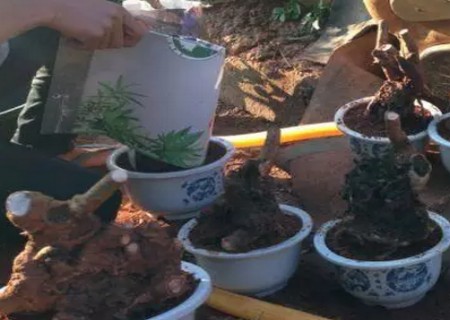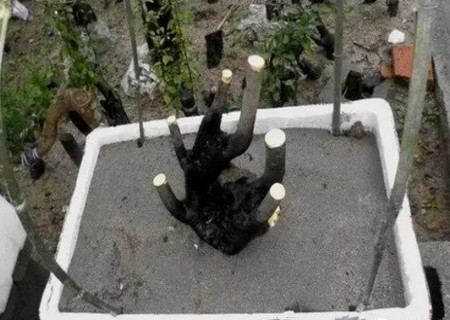Transplanting method of mountain piles under bonsai
The downhill stump, that is, the wild tree stump dug in the mountain, is used as bonsai material. In general, such materials have strange, dangerous, simple and elegant effects that are difficult to achieve by hand. Perhaps, your burning material is someone else's bonsai material. According to his own understanding of bonsai pile transplantation for more than ten years, combined with his own cultivation experience, the editor talks about one point and discusses with colleagues in bonsai circles in order to improve each other and make a modest contribution to the prosperity of bonsai art.

1. Transplant time
The best time for transplanting bonsai piles is from early March to late April after the temperature in Yangchun gets warmer. The fibrous root should be preserved as far as possible during transplant, which is the lifeline for the survival of this pile and the normal delivery of nutrients. Therefore, the key to the survival of the new pile is to understand the ecological habits of all kinds of tree species and the selection of local climatic conditions.
2. Planting preparation
After all the transplanted new piles and the mountain piles purchased from the farmers on the market are returned, the first thing to do is to put the new piles in a pool or soak them in a large water tank for about 24 hours, which can reduce the probability that the new piles will die due to dehydration. In the process of soaking, the whole pile must not be submerged under water, which will cause the pile head to suffocate completely. It is OK to submerge 2/3 of the lower part of the new pile, and it should not be soaked for too long so that it can fully absorb enough water.
3. Pile material treatment
1) first of all, it is necessary to examine the pile, and we should first draw the forming diagram of the pile in mind.
2) after making a draft, you can put down the pile boldly and meticulously, strive for one step to be clean and clean, and don't drag your feet.
3) after putting down the pile, be sure to cut the cut flat, make sure that the pile body is uneven and the sawing point is smooth, and that there are no cracks in the bark and xylem.
4) after flattening the pile wound, apply it evenly with white latex or wound healing agent, and then cover it with black plastic film to ensure that the water in the pile does not flow out of the wound and prevent branch retraction and germ invasion.
5) choose a suitable purple sand basin or general plain burning mud basin to plant or pile soil pseudo-planting, the basin can be a little larger, which is beneficial to the root system to stretch and survive.
4. Watering
Reasonable watering is one of the keys to the survival of the new pile. Watering mainly depends on the degree of dryness and wetness of the basin soil. generally, it is necessary to keep the basin soil moist, and it also depends on the characteristics of tree species. It doesn't matter to water more moisture-resistant tree species, such as boxwood, Chinan, and so on. Afraid of wet tree species can not be watered, as long as keep the basin soil moist, such as pine, elm, Zhe wood and so on. For these tree species, you can spray more on the trunk and water less, especially if you use undrained soil, let alone more watering.
5. Fertilization
Under normal circumstances, the new pile is not fertilized in that year. Some tree species with fast growth and high fertilizer consumption can also apply a small amount of fertilizer after autumn, such as elm, white wax and so on. Fertilization is mainly based on thin fertilizer, and do not apply thick fertilizer. Some tree species cannot be fertilized that year, such as pine, cypress, rhododendron, alpinia, and so on, because their new roots sprouted less and could not fully survive, and their ability to bear fertilizer was also poor.
6. Branch and bud thinning
Generally speaking, the stakes do not move branches and shears in the first two years, so that the branches can grow vigorously as far as possible, so as to achieve the goal of growing, thickening and strengthening in the early stage. According to the requirements of modeling, you can properly remove the excess branches, but you must leave a few more prepared branches in the parts of the useful branches, waiting for the strongest branches to be left in the coming year and cut off the extra branches.
The following points should be done for the new pile to be planted downhill:
The main results are as follows: 1. The new pile should be sprayed with a spray can more than ten times a day until the pile sprouts and the extracted branches are completely Lignified, so as to achieve the purpose of non-dewatering and shrinking branches.
2. Spray or sprinkle water around all the new pile basins to fully maintain the humidity of the air so as to facilitate the early survival of the pile head.
3. It is best to place the new pile in the shade where you can naturally come into contact with some scattered sunlight; if you do not have such conditions, you can set up a sunshade net and grass curtain to shade the sun properly, the new pile can not be placed directly in the strong sun.
4. The transplanted new pile must not be placed on the tuyere to let the strong air flow blow directly, which is easy to cause dehydration and branch shrinkage and death.
Time: 2019-06-03 Click:
- Prev

How to plant mountain piles under bonsai
The determination of the transplanting time of bonsai piles has always had its own opinions. According to my own experience of planting piles, it is generally necessary to vary from time to time and from place to place, and should not be treated rigidly. The transplanting time in our southwest region should generally be free of rain, snow and frost, and deciduous trees and cypresses can be transplanted before the Waking of Insects in the early winter to the following year.
- Next

Cultivation and maintenance of Finch Plum under Mountain pile
Finch plum belongs to Rhamnaceae, with peculiar roots and elegant tree posture. It is one of the main tree species of Chinese stump bonsai, one of the five famous trees in Lingnan bonsai, and one of the bonsai plants exported to the United States after China's entry into WTO. Finch plum fruit is edible, sour and sweet, hence the name sour plum fruit, tender leaves can be used instead of tea
Related
- Fuxing push coffee new agricultural production and marketing class: lack of small-scale processing plants
- Jujube rice field leisure farm deep ploughing Yilan for five years to create a space for organic food and play
- Nongyu Farm-A trial of organic papaya for brave women with advanced technology
- Four points for attention in the prevention and control of diseases and insect pests of edible fungi
- How to add nutrient solution to Edible Fungi
- Is there any good way to control edible fungus mites?
- Open Inoculation Technology of Edible Fungi
- Is there any clever way to use fertilizer for edible fungus in winter?
- What agents are used to kill the pathogens of edible fungi in the mushroom shed?
- Rapid drying of Edible Fungi

